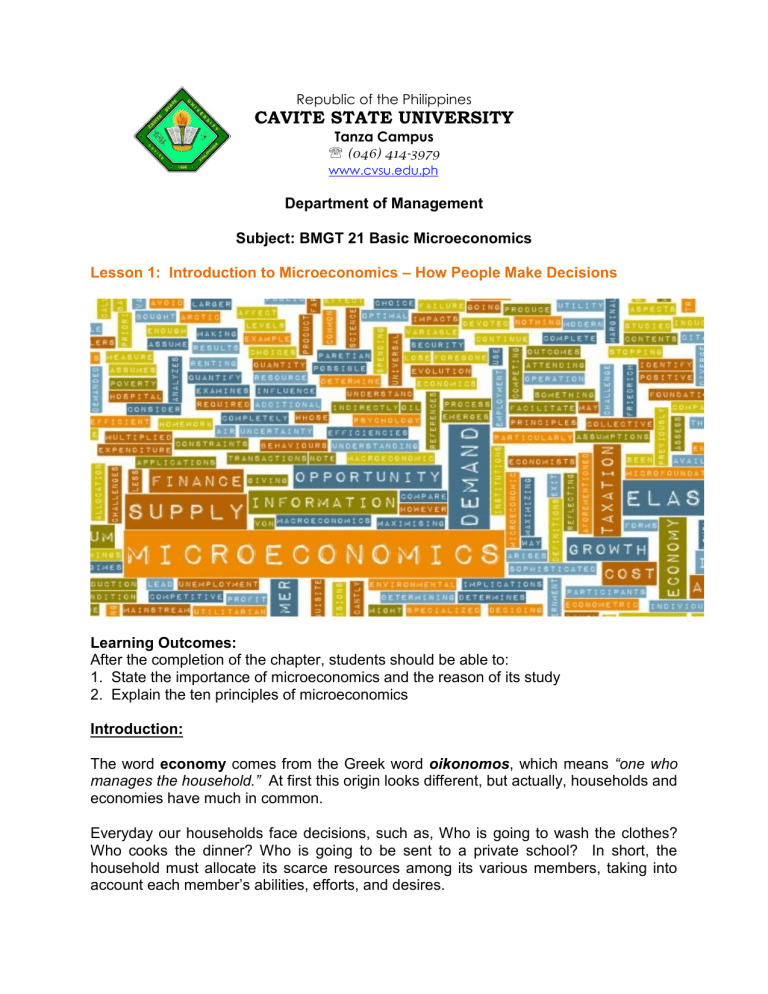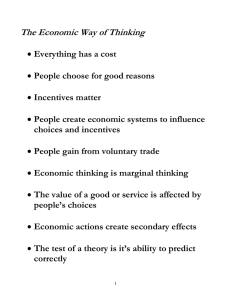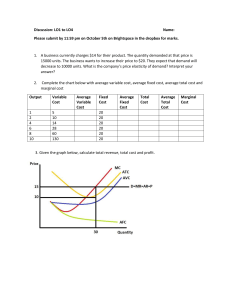
Republic of the Philippines CAVITE STATE UNIVERSITY Tanza Campus (046) 414-3979 www.cvsu.edu.ph Department of Management Subject: BMGT 21 Basic Microeconomics Lesson 1: Introduction to Microeconomics – How People Make Decisions Learning Outcomes: After the completion of the chapter, students should be able to: 1. State the importance of microeconomics and the reason of its study 2. Explain the ten principles of microeconomics Introduction: The word economy comes from the Greek word oikonomos, which means “one who manages the household.” At first this origin looks different, but actually, households and economies have much in common. Everyday our households face decisions, such as, Who is going to wash the clothes? Who cooks the dinner? Who is going to be sent to a private school? In short, the household must allocate its scarce resources among its various members, taking into account each member’s abilities, efforts, and desires. Like a household, a society faces many decisions. A society must find some way to decide what jobs will be done and who will do them. It needs some people to grow food, other people to make clothing, and still others to design computer software. Once society has allocated people (as well as land, buildings, and machines) to various jobs, it must also allocate the output of goods and services they produce. It must decide who will eat the beef and who will eat the fishes. The proper management of society’s resources is important because resources are scarce. Scarcity means that society has limited resources and therefore cannot produce all the goods and people wish to have. Just like households cannot get everything they wish to have or the standard of living they want. Economics is the study of how society manages its scarce resources. In this lesson, we will study the Ten Principles of Economics so we will fully understand why and how people make decisions. DISCUSSION: Principle 1: People Face Trade-offs We oftentimes hear the saying, “There is no such thing as a free lunch.” There is much truth to this saying. To get one thing that we like, we usually have to give up another thing that we like. Making decisions requires trading off one goal against another. Consider yourself, on how you allocate your valuable time. You can spend all your time studying microeconomics or you can divide your time to all your subjects but for every hour you study microeconomics, you are giving up that hour you could have spent to other subjects. And for every hour you spend studying, you have given up the time you could have played mobile legends or napping or watching TV. In our society, the more our government spends for national defense to protect us from foreign aggressors, the lesser it could spend on for our national health protection. Another trade-off society faces is between efficiency and equality. Efficiency means that society is getting the maximum benefits from its scarce resources. Equality means that those benefits are distributed uniformly among society’s members. In other words, efficiency refers to the size of the economic pie, and equality refers to how the pie is divided into individual slices. Recognizing that people face trade-offs does not by itself tell us what decisions they or should make. Society should not stop protecting environment just because environmental regulations reduce our material standard of living. Our study of economics starts by acknowledging life’s trade-offs. PRINCIPLE 2: The Cost of Something Is What You Give Up to Get It Because people face trade-offs, making decisions requires comparing the costs and benefits of alternative courses of action. In many cases, the cost of an action is not as obvious as it might first appear. Consider the decision to go to college. The main benefits are intellectual enrichment and a lifetime of better job opportunities. But what are the costs? The money you spent on books, room, and board. Yet this total does not truly represent what you give up to spend a year in college. There are two problems with this calculation. First, it includes some things that are not really costs of going to college. Even if you quit school, you need a place to sleep and food to eat. Room and board are costs of going to college only to the extent that they are more expensive at college than elsewhere. Second, this calculation ignores the largest cost of going to college – your time. When you spend a year listening to lectures, reading textbooks, and writing papers, you cannot spend that time working at a job. For some students, the earnings given up to attend school are the largest single cost of their education. The opportunity cost of an item is what you give up to get that item. When making any decision, decision makers should be aware of the opportunity costs that accompany each possible action. College athletes who can earn millions if they drop out of school and play professional sports are well aware that their opportunity cost of college is very high. It is not surprising that they often decide that the benefit is not worth the cost. BASKETBALL STAR LEBRON JAMES UNDERSTANDS OPPORTUNITY COST AND INCENTIVES. HE DECIDED TO SKIP COLLEGE AND GO STRAIGHT TO THE PROS, WHERE HE HAS EARNED MILLIONS OF DOLLARS AS ONE OF THE NBA’S TOP PLAYERS. PRINCIPLE 3: RATIONALE PEOPLE THINK AT THE MARGIN Economists normally assume that people are rational. Rational people systematically and purposefully do the best they can to achieve their objectives, given the available opportunities. As you study economics, you will encounter firms that they decide how many workers to hire and how much of their product to manufacture and sell to maximize profits. You will also encounter individuals who decide how much time to spend working and what goods and services to buy with the resulting income to achieve the highest possible level of satisfaction. When exams rolls around, your decision is not between blowing them off or studying 24 hours a day but whether to spend extra hour reviewing your notes instead of watching TV. Economists use the term marginal changes to describe small incremental adjustments to an existing plan of action. Keep in mind that margin means “edge”, so marginal changes are adjustments around the edges of what you are doing. Rational people often make decisions by comparing marginal benefits and marginal costs. Marginal decision making can help explain some otherwise puzzling economic phenomena. Here is classic question: Why is water so cheap, while diamonds are so expensive? Humans need water to survive, while diamonds are unnecessary; but for some reason, people are willing to pay much more for a diamond than for a cup of water. The reason is that a person’s willingness to pay for any good is based on the marginal benefit that an extra unit of the good would yield. The marginal benefit, in turn, depends on how may units a person already has. Water is essential, but the marginal benefit of an extra cup is small because water is plentiful. By contrast, no one needs diamonds to survive, but because diamonds are so rare, people consider the marginal benefit of an extra diamond to be large. A rational decision maker takes an action if and only if the marginal benefit of the action exceeds the marginal cost. The principle can explain why people are willing to pay more for diamonds than for water. It can take some time to get used of the logic of marginal thinking but the study of economics will give you ample opportunity to practice. PRINCIPLE 4: PEOPLE RESPOND TO INCENTIVES An incentive is something that induces a person to act, such as the prospect of a punishment or a reward. Because rational people make decisions by comparing costs and benefits, they respond to incentives. You will see that incentives play a central role in the study of economics. Incentives are crucial to analyzing how markets work. For example, when the price of an apple rises, people decide to eat fewer apples. At the same time, apple orchards decide to hire more workers and harvest more apples. In other words, a higher price in market provides an incentive for buyers to consume less and an incentive for sellers to produce more. As we will see, the influence of prices on the behaviors of consumers and produces is crucial for how a market economy allocates scarce resources. Public policy makers should never forget about incentives: many policies change the costs or benefits that people face and, therefore, alter their behavior. A tax on gasoline, for instance, encourages people to drive smaller, more fuel-efficient cars. That is one reason people drive smaller cars in Europe, where gasoline taxes are high, than in the United States, where gasoline taxes are low. A gasoline tax also encourages people to carpool, take public transportation, and live closer to where they work. If the tax were larger, more people would be driving hybrid cars, and if it were large enough, they would switch to electric cars. When policymakers fail to consider how their policies affect incentives, they often end up with unintended consequences. For example, consider public policy regarding auto safety. Today, all cars have seat belts, but this was not true 50 years ago. In the 1960s, Ralph Nader’s book Unsafe at Any Speed generated much public concern over auto safety. Congress responded with laws requiring seat belts as standard equipment on new cars. How does a seat belt law affect auto safety? The direct effect is obvious: When a person wears a seat belt, the probability of surviving an auto accident rises. But that’s not the end of the story because the law also affects behavior by altering incentives. The relevant behavior here is the speed and care with which drivers operate their cars. Driving slowly and carefully is costly because it uses the driver’s time and energy. When deciding how safely to drive, rational people compare, perhaps unconsciously, the marginal benefit from safer driving to the marginal cost. As result, they drive more slowly and carefully when the benefit of increased safety is high. For example, when road conditions are icy, people drive more attentively and at lower speeds than they do when road conditions are clear. Consider how a seat belt law alters a driver’s cost– benefit calculation. Seat belts make accidents less costly because they reduce the likelihood of injury or death. In other words, seat belts reduce the benefits of slow and careful driving. People respond to seat belts as they would to an improvement in road conditions—by driving faster and less carefully. The result of a seat belt law, therefore, is a larger number of accidents. The decline in safe driving has a clear, adverse impact on pedestrians, who are more likely to find themselves in an accident but (unlike the drivers) don’t have the benefit of added protection. At first, this discussion of incentives and seat belts might seem like idle speculation. Yet in a classic 1975 study, economist Sam Peltzman argued that auto-safety laws have had many of these effects. According to Peltzman’s evidence, these laws produce both fewer deaths per accident and more accidents. He concluded that the net result is little change in the number of driver deaths and an increase in the number of pedestrian deaths. Peltzman’s analysis of auto safety is an offbeat example of the general principle that people respond to incentives. When analyzing any policy, we must consider not only the direct effects but also the less obvious indirect effects that work through incentives. If the policy changes incentives, it will cause people to alter their behavior. SUMMARY: The fundamental lessons about individual decision making are that people face tradeoffs among alternative goals, that the cost of any action is measured in terms of forgone opportunities, that rational people make decisions by comparing marginal costs and marginal benefits, and that people change their behavior in response to the incentives they face. TERMINOLOGY TO REVIEW Economics Scarcity Efficiency Equality Trade-offs Opportunity Cost Incentives Marginal Benefits Marginal Costs REFERENCE E-BOOK: Principle of Microeconomics by N. Gregory Mankiw, Chapter 1 pages 5 to 7 END OF LESSON 1 Prepared by: JOHNNY RICK S. APELLANES Instructor I








